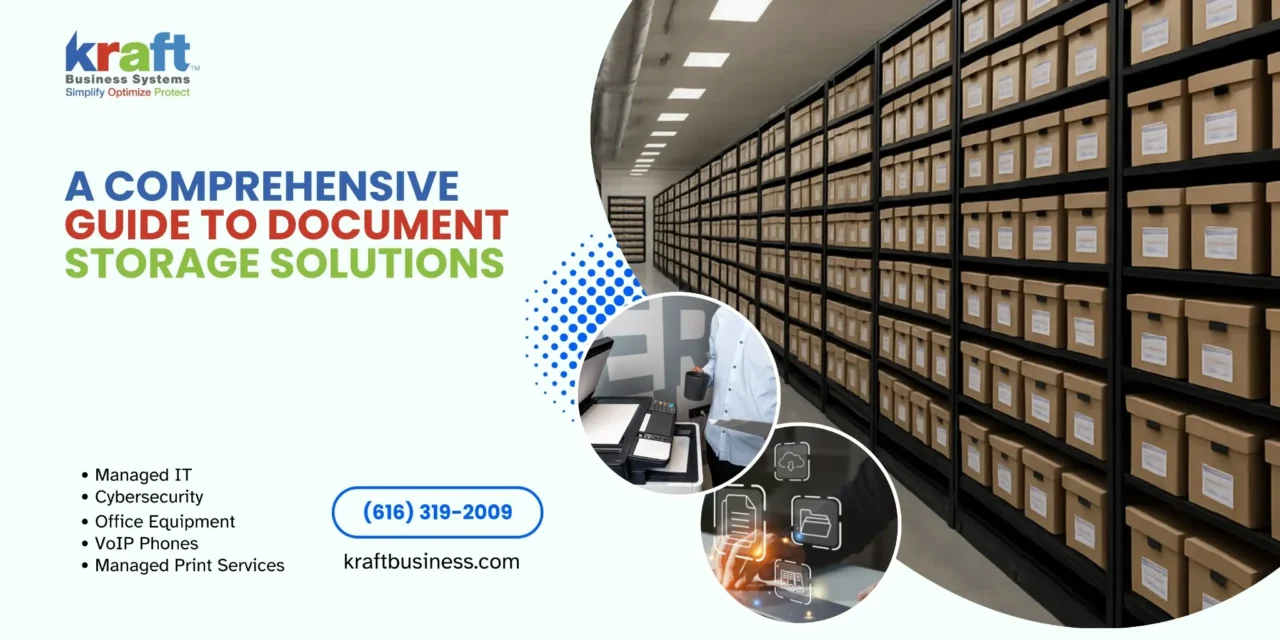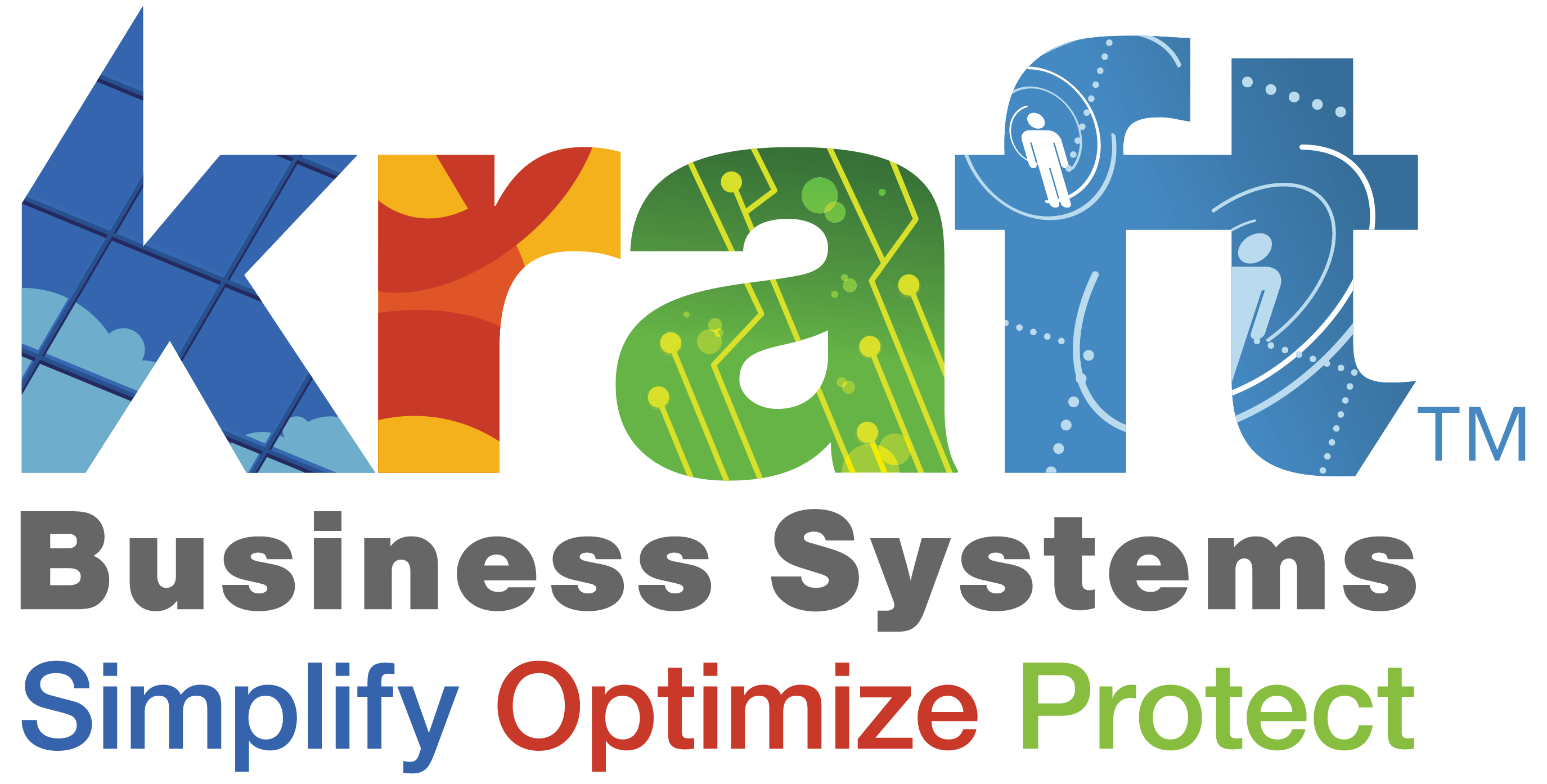Document storage solutions are secure systems for organizing, accessing, and preserving important business files and records. These solutions help businesses maintain compliance, improve efficiency, and protect critical information.
For businesses seeking immediate guidance on document storage options, here are the main types:
| Type of Solution | Best For | Key Benefits |
|---|---|---|
| Cloud Storage | Remote teams, scalability | Accessibility from anywhere, automatic backups |
| On-Premise Systems | High security needs, legacy integration | Complete control, no internet dependency |
| Hybrid Solutions | Balanced approach | Flexibility, phased migration capability |
| Physical Archives | Legal requirements, historical records | Compliance with certain regulations |
| Industry-Specific Vaults | Regulated sectors (healthcare, finance) | Built-in compliance features |
Businesses spend thousands of dollars each year dealing with misfiled or lost documents. According to research, companies with around 1,000 employees waste an estimated $2.5-$3.5 million annually just trying to locate information. The average employee spends 50% of their time searching for documents, with each misfiled document costing about $120 to find and $220 to reproduce if lost.
Document storage has evolved from physical filing cabinets to sophisticated digital systems that offer security, accessibility, and integration capabilities. Today’s solutions range from simple cloud repositories to comprehensive document management systems with advanced features like version control, workflow automation, and regulatory compliance tools.
Why does this matter for your business? Beyond just “storing files,” modern document storage solutions transform how teams collaborate, ensure business continuity during disruptions, and protect sensitive information from security threats. They also help businesses meet increasingly strict data protection regulations while reducing the physical space and resources needed for paper storage.
The right document storage solution depends on your specific needs: volume of documents, security requirements, access patterns, compliance obligations, and budget constraints. Whether you’re looking to go paperless, improve remote work capabilities, or strengthen your data governance, understanding the landscape of available options is the first step.

Easy document storage solutions glossary:
Why Modern Businesses Need Robust Storage
The exponential growth of data has transformed how businesses operate. With organizations generating more documents than ever before, the need for robust document storage solutions has never been more critical.
“Organizing your content while trying to maintain regulatory compliance and data governance is a common challenge today — especially when content is siloed, shadow IT exists, and compliance standards are evolving,” notes a leading industry expert.
Modern work environments demand seamless collaboration across hybrid teams. Whether your employees are working from your Grand Rapids headquarters or remotely from Traverse City, they need immediate access to critical documents. Without proper storage solutions, teams waste valuable time searching for information instead of using it productively.
As one IT manager shared with us, “Before implementing a proper document storage system, our team spent nearly 20 minutes on average just trying to locate the right version of a file. Now it takes seconds.”
Exploring Document Storage Solutions: Types & Benefits
How to Evaluate Document Storage Solutions
Choosing the right document storage solution isn’t just about finding a place to keep your files—it’s about finding a system that works the way your team does. At Kraft Business Systems, we always recommend starting with a simple question: what problems are you trying to solve?

When our clients sit down to evaluate their options, we guide them through five key considerations:
First, think about scalability. That solution that works perfectly for your small team in Ann Arbor might become a bottleneck if you expand to Detroit or Lansing. You need room to grow without starting over.
Next, examine the security layers. Good security isn’t just a single lock—it’s multiple protective barriers working together. Look for encryption, varied access controls, and detailed audit trails that show who touched what and when.
Your regulatory fit matters tremendously. Healthcare organizations across Michigan need HIPAA-compliant solutions, while manufacturing firms have different requirements entirely. Your document system should help with compliance, not create new headaches.
Don’t overlook integration capabilities. A document storage system that plays nicely with your existing tools will save countless hours of frustration. As one of our clients put it, “The best system is one you barely notice you’re using.”
Finally, be realistic about your budget. The sticker price is just the beginning—factor in implementation time, training needs, ongoing maintenance, and future scaling costs to understand the true investment.
As we’ve noted in our Document Management Trends research, the most successful implementations align with your existing workflows rather than forcing your team to change how they work.
Core Features Checklist for Document Storage Solutions
When evaluating potential document storage solutions, certain features shouldn’t be negotiable. Think of these as your must-haves:
Access controls give you the power to decide who sees what. Your accounting team doesn’t need access to HR documents, and your marketing team probably shouldn’t be browsing customer financial data.
Encryption-at-rest protects your information even when it’s just sitting there. Think of it as a safe that remains locked even when nobody’s trying to open it.
Version control prevents the chaos of multiple document versions floating around. It answers the eternal question: “Is this the latest version?” with confidence.
Audit trails create accountability by tracking who accessed documents and when. This isn’t about policing your team—it’s about protection and compliance.
APIs and integrations connect your document system with other business tools, creating a seamless experience rather than digital silos.
Good search functionality saves hours of frustration. When a client calls with a question about their account from three years ago, you need that information now, not after a 20-minute hunt.
Mobile access acknowledges that work happens everywhere. Your team needs secure access whether they’re at your Grand Rapids office or meeting clients in Traverse City.
Limitations of Basic Document Storage Solutions (vs. DMS)
Basic document storage solutions can be a good starting point, but they often reveal their limitations as your business grows. Understanding these constraints helps you make informed decisions about when to upgrade.
The most noticeable limitation is minimal workflows. Basic systems essentially create digital filing cabinets—they store things well but don’t help move documents through approval processes or business cycles. Everything remains manual.
You’ll also encounter weak metadata management. Without robust tagging and categorization, finding specific information becomes like searching for a needle in a digital haystack as your document library grows.
Basic systems typically offer manual retention policies at best. This means someone on your team needs to remember when documents should be archived or deleted—a recipe for compliance risks in regulated industries.
Perhaps most frustrating are the siloed systems that don’t talk to each other. When your document storage doesn’t connect with your CRM or accounting software, you end up with information islands and duplicate work.
A client in Warren shared their experience: “We started with basic cloud storage because it was cheap and easy. Two years and thousands of documents later, we realized we were spending more time managing files than using them. Upgrading to a proper document management system was like hiring an extra employee—suddenly everything was organized and findable.”
Exploring Document Storage Solutions: Types & Benefits
Cloud-Based Repositories
Cloud-based document storage solutions have transformed how businesses handle their information. Instead of housing documents on physical servers in your office, cloud repositories store everything on remote servers you can access through the internet – making your important files available whenever and wherever you need them.

What makes cloud repositories special is their incredible flexibility. Need more storage this month because of a big project? You can scale up instantly without buying new hardware. When the project wraps up, simply scale back down. This elasticity means you only pay for what you actually use.
The Software-as-a-Service (SaaS) model turns what used to be major capital investments into manageable monthly expenses. Even better, you can say goodbye to maintenance headaches – your provider handles all updates, patches, and hardware issues behind the scenes while you focus on your actual business.
“Cloud repositories put enterprise-grade document storage in everyone’s hands,” explains one of our specialists at Kraft Business Systems. “A small family business in Benzonia has access to the same powerful technology as major corporations in Detroit.”
As detailed in our Digital Document Storage guide, most cloud providers guarantee impressive uptime – typically 99.9% or better – ensuring your documents are available when you need them. And with secure mobile access, your team can retrieve critical files from anywhere with an internet connection, whether they’re visiting clients in Kalamazoo or working from home in Holland.
Benefits of Cloud Document Storage Solutions
The advantages of cloud-based document storage solutions go far beyond simple convenience. They can fundamentally improve how your business operates.
First, they’re remarkably cost-effective. One of our manufacturing clients in Wyoming, MI cut their document storage expenses by 40% after moving to the cloud. By eliminating server hardware, maintenance fees, and reducing IT overhead, cloud storage delivers serious savings.
Speed is another major benefit. While traditional storage systems might take months to implement, cloud solutions can be up and running in days or weeks. A law firm we work with in Ann Arbor was fully operational on their new platform within just two weeks of deciding to make the switch.
Cloud providers also build redundancy into their systems by automatically duplicating your data across multiple locations. This built-in disaster recovery protection means even if one data center experiences problems, your documents remain safe and accessible.
For teams spread across different locations, cloud storage is a game-changer. “It feels like we’re all working in the same room,” shared a client with offices in both Traverse City and Grand Rapids, “even though we’re 140 miles apart.” This seamless collaboration happens because everyone accesses the same documents in real-time.
You’ll also benefit from continuous improvements without disruption, as providers regularly improve security features and capabilities behind the scenes.
Compliance & Security in Cloud Document Storage Solutions
Many businesses initially worry about security when considering cloud document storage solutions. However, modern cloud platforms typically offer protection that surpasses what most organizations could implement themselves.
Today’s leading cloud providers support comprehensive regulatory compliance frameworks including GDPR, HIPAA, SOC 2, PCI DSS, and FedRAMP. This built-in compliance is particularly valuable for specialized industries. As one financial services client in Detroit told us, “Our cloud repository came preconfigured with all the security controls our regulators require, saving us months of compliance work.”
Multifactor authentication adds an essential layer of security beyond passwords, while continuous 24/7 monitoring means potential threats are detected and addressed immediately. Your data receives encryption protection both when it’s being transferred and when it’s sitting in storage.
For businesses facing regular audits, automated compliance reporting simplifies what used to be a stressful process. A healthcare provider in Lansing who implemented a HIPAA-compliant solution shared, “With bank-level security, our cloud document storage system sets the standard for professional service firms.”
At Kraft Business Systems, we help Michigan businesses find cloud storage solutions that balance security, accessibility, and compliance – creating systems that protect your documents while keeping them readily available to the people who need them.
Exploring Document Storage Solutions: Types & Benefits
On-Premise File Servers & Private Clouds
For organizations with specific security or operational requirements, on-premise document storage solutions remain a viable option. These systems put you in the driver’s seat of your document infrastructure, giving you complete control from the server hardware right down to the most detailed access policies.

Think of on-premise solutions as having your own personal document vault right in your building. They offer several distinct advantages that many Michigan businesses still find compelling:
Hardware control means you own and manage the physical infrastructure, giving you the final say in how everything operates. Your firewall isolation keeps documents safely behind your security perimeter, adding an extra layer of protection that some organizations require.
Many of our clients appreciate the capital expenditure model – making a one-time investment rather than paying ongoing subscriptions. For office-based teams, the LAN speed access provides noticeably faster document retrieval compared to internet-dependent solutions.
If your business runs specialized or older systems, on-premise storage offers superior legacy application support, allowing direct integration with business systems that might struggle with cloud connectivity.
As we explain in our Build a Document Management System guide, “On-premise solutions provide the highest degree of control and customization, allowing organizations to tailor every aspect of their document storage environment.”
When On-Premise Beats Cloud Document Storage Solutions
While cloud solutions dominate most conversations these days, certain scenarios make on-premise document storage solutions the smarter choice:
When facing strict data residency requirements, local storage might be your only option. One government contractor we work with in Detroit implemented an on-premise solution specifically to comply with data sovereignty regulations that required all information to remain physically within certain boundaries.
For businesses with ultra-low latency needs, every millisecond counts. A manufacturing client in Sterling Heights chose on-premise storage because their production systems couldn’t tolerate even the slightest delay in document access.
Organizations with bespoke configurations often find on-premise solutions more accommodating. A research institution we support in Ann Arbor deployed custom on-premise storage specifically designed to handle their unique proprietary data formats – something no off-the-shelf cloud solution could manage.
Sometimes it simply makes sense to leverage your existing infrastructure. As one financial services company in Grand Rapids told us, “We already had significant investments in our data centers, so expanding our on-premise solution made more financial sense than starting from scratch with cloud migration.”
Maintenance & Hidden Costs
While on-premise document storage solutions give you control advantages, they also come with responsibilities and costs that aren’t always obvious during initial planning:
Running your own servers means planning for server refresh cycles – most hardware requires replacement every 3-5 years. You’ll also need to stay on top of patch management with regular security and software updates to keep everything running smoothly and securely.
The practical costs add up too. Power and cooling create ongoing utility expenses, while physical security measures are essential to protect your hardware from unauthorized access. Don’t forget about backup systems – you’ll need redundant storage to prevent devastating data loss.
Perhaps most importantly, on-premise solutions require IT expertise. As one healthcare administrator from Dearborn shared with us, “We initially chose on-premise storage thinking we’d save money, but after factoring in all the maintenance expenses and additional IT staff time over five years, we realized a cloud solution would have been more economical.”
Understanding these hidden costs is crucial for accurate budget planning. Our experience at Kraft Business Systems has shown that the purchase price of on-premise storage hardware typically represents only 20-30% of the total five-year cost of ownership – something worth considering before making your final decision.
Exploring Document Storage Solutions: Types & Benefits
Hybrid Document Storage Solutions
Hybrid document storage solutions give you the best of both worlds by combining cloud and on-premise approaches. Think of it as having your cake and eating it too – perfect for businesses with diverse document needs.

What makes hybrid solutions special is how they bring everything together. You get a single interface to manage all your documents, whether they’re stored locally or in the cloud. This means your team doesn’t need to learn multiple systems or jump between platforms to find what they need.
Many of our Michigan clients appreciate the tiered storage approach. You can keep frequently accessed documents on your local servers for speed, while moving archives and less-used files to the cloud to save space. As one client put it, “It’s like having a file cabinet right next to you for everyday stuff, but with a massive library just a click away when you need something special.”
Our Integrated Document Management Solutions guide explains how this balanced approach helps businesses maintain critical documents on-premise while still taking advantage of cloud benefits for collaboration and disaster recovery.
Advantages of Hybrid Document Storage Solutions
The flexibility of hybrid document storage solutions makes them increasingly popular with businesses across Michigan. Here’s why:
Workload flexibility lets you place documents where they make the most sense. A law firm with offices in both Detroit and Traverse City keeps client files in the cloud so attorneys in both locations can collaborate easily, while maintaining financial records on-premise for extra security.
Phased cloud adoption means you can move at your own pace. One of our manufacturing clients in Flint gradually transitioned departments to cloud storage over 18 months, which minimized disruption and gave employees time to adjust. “Our staff appreciated not having to change everything overnight,” their IT manager told us.
Disaster recovery becomes much more robust. A medical practice in Ann Arbor keeps their primary records on-site but automatically backs everything up to the cloud. When a water leak threatened their server room last winter, they didn’t lose a single minute of access to patient records.
Cost optimization happens naturally as you balance capital and operational expenses. A retail business headquartered in Grand Rapids stores large product images and videos on-premise (avoiding cloud bandwidth charges) while keeping business documents in the cloud for easy access by store managers across Michigan.
Governance Across Hybrid Document Storage Solutions
Managing documents across different storage locations can get tricky without proper governance. The best hybrid document storage solutions solve this with several important features:
Unified policies ensure consistency is maintained no matter where your documents live. This means the same rules for document classification, retention, and security apply everywhere, preventing confusion and compliance gaps.
Metadata synchronization might sound technical, but it’s simply about making sure document attributes stay consistent across platforms. This ensures you can always find what you need, regardless of where it’s stored.
Single sign-on capabilities mean your team logs in once and gets access to everything they’re authorized to see. No more password juggling or multiple logins! As one user from Lansing told us, “It feels like one system, even though I know some files are in the cloud and others are on our servers.”
Centralized monitoring gives you complete visibility into document access and usage patterns. This holistic view helps spot unusual activity and ensures nothing falls through the cracks between systems.
Cross-platform audit trails create comprehensive records of who accessed what documents and when – regardless of storage location. This is especially valuable for regulated industries where documentation of all document interactions is required.
“The secret to successful hybrid document governance is treating all your storage locations as one unified system, even when they’re physically separate,” explains our IT director who has helped clients from Detroit to Traverse City implement seamless hybrid solutions.
Exploring Document Storage Solutions: Types & Benefits
Industry-Specific Hosted Vaults
For organizations in highly regulated industries, specialized document storage solutions called hosted vaults offer preconfigured compliance features and industry-specific functionality.

Think of these vaults as digital fortresses built specifically for your industry. They’re not just regular storage—they come ready to handle your unique challenges right out of the box.
These purpose-built repositories include compliance bundles with preconfigured settings that match your industry regulations, so you’re not starting from scratch. They also feature specialized workflows designed for specific sectors—whether you’re processing patient records or managing student files.
Many of our Michigan clients appreciate the retention templates that come with these systems. These predefined document lifecycle policies take the guesswork out of how long to keep different types of records. Plus, the industry-specific metadata fields make organizing and finding documents much more intuitive for your team.
As highlighted in our Education Document Management: An Educator’s Best Friend resource, “Purpose-built document vaults for education institutions simplify FERPA compliance while supporting the unique document workflows found in academic environments.”
Custom Document Storage Solutions for Regulated Sectors
When you work in a regulated industry, generic storage solutions just don’t cut it. That’s where custom document storage solutions shine by addressing your specific compliance needs.
For healthcare organizations across Michigan, from small clinics in Central Lake to major hospitals in Detroit, HIPAA-compliant storage provides essential patient record protections. These systems integrate seamlessly with your existing electronic health record systems and offer secure patient portals for safe information sharing.
Financial services firms benefit from features specifically designed for SEC and FINRA compliance. Automated retention schedules ensure financial records are kept exactly as long as regulations require—no more, no less. Plus, secure client document exchange features protect sensitive financial information.
Legal professionals appreciate matter-centric organization that mirrors how they actually work. Court filing integration streamlines what used to be tedious processes, while robust client confidentiality protections help maintain ethical obligations.
For schools and universities, FERPA compliance controls come built-in, taking the stress out of student record management. Transcript and credential storage features are designed specifically for educational contexts, making life easier for administrators and registrars alike.
“Our vault system doesn’t just store documents—it understands what a healthcare practice actually needs,” shared one of our clients, a practice manager from Grand Rapids. “The audit-ready features alone have saved us countless hours during compliance reviews.”
Case Snapshot: Meeting HIPAA & FERPA with Hosted Vaults
Let me share how real Michigan organizations are using these specialized document storage solutions to solve real problems.
A multi-location medical practice serving patients across Northern Michigan implemented a HIPAA-compliant hosted vault that transformed their operations. Before the implementation, they conducted a comprehensive risk assessment to identify potential vulnerabilities. Then they set up role-based permissions that perfectly aligned with clinical responsibilities—doctors see what doctors need to see, nurses access what’s relevant to their work, and administrative staff have appropriate limitations.
Their secure patient portal now allows for safe document exchange without resorting to email. Meanwhile, automated audit trails create documentation that proves compliance during inspections. The whole system integrates with their practice management software, creating a seamless experience.
“The hosted vault eliminated our compliance concerns while actually improving our clinical workflows,” the practice administrator told us. “Providers in our Traverse City and Bellaire locations can now securely access the same patient record simultaneously.”
On the education front, a school district with facilities spread across multiple Michigan communities deployed a FERPA-compliant document vault that revolutionized their student record management. Their solution features granular permissions based on educational roles—teachers see only their students, counselors have appropriate access, and administrators can view records across the district.
Parents access their children’s documents through a secure portal, eliminating paper forms and lost permission slips. Automated retention policies ensure student records are kept for exactly the legally required timeframes. And the entire system integrates with their student information system for a unified experience.
As their technology director put it, “Managing student records across multiple schools used to be a logistical nightmare. Our hosted vault ensures compliance while making records instantly available to authorized staff regardless of which building they’re in.”
These specialized vaults don’t just store your documents—they understand your industry’s unique challenges and solve them right out of the box.
Exploring Document Storage Solutions: Types & Benefits
Physical Offsite Archival & Scan-on-Demand
Even as businesses accept digital change, physical document storage solutions continue to play an important role for certain types of records and compliance requirements.

Modern physical archival services have come a long way from the dusty file rooms of the past. These sophisticated facilities offer features that blend old-school security with new-age convenience. Your boxes aren’t just stored—they’re tracked with precision barcoding systems that make retrieval quick and accurate.
“We know exactly where every document is at all times,” explains one records manager who oversees a climate-controlled warehouse serving Michigan businesses. “When a client needs a specific document, we can locate it within minutes, not days.”
These facilities maintain perfect temperature and humidity levels to preserve your documents for decades. Many also offer scan-on-demand services, where they’ll digitize specific documents when you need them, giving you digital access to physical records without a full conversion project. Most importantly, they provide guaranteed retrieval timeframes through defined SLAs, so you’re never left waiting when you need critical information.
As we detail in our Document Archive Solutions guide, these services essentially give you the best of both worlds—the legal standing of original documents with the convenience of digital delivery when needed.
When Physical Storage Still Makes Sense
While digital solutions dominate conversations about modern business, several situations make physical document storage solutions not just useful, but necessary:
For historical records with cultural significance, physical preservation remains essential. A city clerk from a small Michigan municipality told us, “Some of our town records date back to the 1850s. While we’ve digitized them for everyday use, preserving the originals is part of our community heritage.”
Legal requirements often dictate keeping original signed documents. A Detroit attorney explained, “For certain contracts and wills, courts still expect to see original signatures when challenged. Digital copies are convenient, but the originals have stronger legal standing.”
Oversized documents like architectural blueprints, engineering drawings, and large-format artwork present unique challenges. “Some of our historical drawings are simply too large and detailed to digitize effectively,” shared a Grand Rapids architecture firm principal.
Documents requiring extremely long-term retention often benefit from physical storage. Universities, hospitals, and government agencies may need to preserve certain records for 50, 75, or even 100+ years—timeframes that exceed the proven lifespan of many digital formats.
The costs of lost documents extend beyond mere inconvenience. As one records management expert pointed out, “When employees can’t find what they need, productivity plummets. Modern physical storage services eliminate this problem through systematic organization.”
Migrating Archives to Digital Document Storage Solutions
For many Michigan organizations, converting physical archives to digital document storage solutions represents a major efficiency opportunity. This migration process typically involves several key steps:
Bulk scanning processes make quick work of large document volumes. A Warren-based manufacturer recently shared their success story: “We digitized over 200,000 pages of technical documentation in just three months. What used to fill an entire room now lives securely in our document management system.”
OCR and indexing technology transforms those scanned images into searchable resources. “Before OCR, finding information in our case files was like searching for a needle in a haystack,” explained a Livonia attorney. “Now we can search by keyword across thousands of documents and find what we need in seconds.”
Metadata improvement during digitization adds tremendous value. A healthcare administrator from Lansing told us, “We didn’t just scan our records—we created a comprehensive taxonomy that makes retrieval intuitive. Staff can find patient history based on treatment type, provider, date range, or dozens of other parameters.”
Secure destruction completes the cycle for many organizations. “After verifying our digital conversions met all quality standards, we implemented a certified shredding program,” said a Detroit financial services director. “This recovered valuable office space while actually improving our security posture.”

One small business owner summed up their digitization experience perfectly: “What used to take days now takes minutes. We scanned 400 documents in a couple of hours with the right tools. The relief of knowing everything is backed up and searchable is worth every penny.”
When planning your migration, proper permission settings are crucial. “Moving files between folders can inadvertently break permissions,” cautions one of our document management specialists. “A methodical approach with careful testing prevents headaches down the road.”
Exploring Document Storage Solutions: Types & Benefits
Implementation Best Practices & Cost Considerations
Successfully implementing document storage solutions requires careful planning and execution. At Kraft Business Systems, we’ve helped organizations across Michigan—from small businesses in Benzonia to large enterprises in Detroit—optimize their document infrastructure.
Key implementation best practices include:
- Assign clear project ownership: Designate a project champion with decision-making authority
- Develop a change management plan: Prepare your team for new processes and tools
- Invest in user training: Ensure everyone knows how to use the new system effectively
- Calculate total cost of ownership: Look beyond initial purchase prices to understand the full financial picture
- Design a comprehensive backup strategy: Protect your documents against all potential threats
As outlined in our Document Management Process guide, “The most successful implementations focus equally on technology, processes, and people.”
One manufacturing client in Sterling Heights shared, “Working with Kraft Business Systems to implement our document storage solution saved us months of trial and error. Their expertise helped us avoid common pitfalls and get it right the first time.”
Maximizing Collaboration & Remote Work
Modern document storage solutions can dramatically improve collaboration, especially for remote and distributed teams:
- Real-time co-authoring: Multiple users can work on the same document simultaneously. A marketing agency with staff in both Grand Rapids and Traverse City uses collaborative editing to streamline content creation.
- Shared workspaces: Organized collections of documents for specific projects or departments. A construction company managing projects across Michigan implemented project-specific document spaces for each job site.
- Mobile capture: Adding documents to the system directly from smartphones and tablets. Field technicians serving clients throughout Michigan now capture and upload documentation while on service calls.
- Version tracking: Maintaining a clear history of document changes and approvals. An accounting firm with offices in multiple Michigan locations uses version control to manage client tax documents through multiple review cycles.
As detailed in our Document Management for Remote Teams resource, “Effective collaboration tools transform document storage from a passive archive into an active workspace that connects employees regardless of location.”
“Stanford study of 1,100 businesses found that those facilitating collaboration are five times more likely to be high-performing,” highlighting the business impact of collaborative document systems.
Backup, DR & Version Control Essentials
Protecting your documents against loss or corruption is a critical aspect of document storage solutions. A comprehensive protection strategy includes:
- Geographic replication: Storing copies of documents in multiple physical locations to guard against regional disasters. A law firm with offices in both Detroit and Traverse City maintains document copies in both locations.
- Immutable backups: Creating backup copies that cannot be altered or deleted, even by administrators. A financial services firm in Ann Arbor implemented write-once backups to protect against ransomware attacks.
- Point-in-time recovery: The ability to restore documents to their state at a specific moment. An engineering firm in Warren uses this capability to recover from accidental document modifications.
- Retention scheduling: Automated policies for document preservation and deletion. A healthcare provider in Lansing implemented retention schedules aligned with HIPAA requirements.
- Automated verification: Regular testing of backup integrity and recoverability. A manufacturing company in Flint performs monthly recovery drills to ensure their document protection systems work as expected.
“Document history for auditing and tracking” and “Version control for documents and backup storage” are consistently rated among the most important features by businesses evaluating storage solutions.
One client noted, “After a ransomware incident affected our server, we recovered all our critical documents within hours thanks to our properly configured backup system. Without it, we might have been forced to pay the ransom.”
Exploring Document Storage Solutions: Types & Benefits
Frequently Asked Questions about Document Storage
What is the main difference between document storage and a full DM system?
Think of document storage solutions as a digital filing cabinet – they keep your files organized and accessible. A full document management system (DMS), however, is more like having both the filing cabinet and a personal assistant who routes documents, reminds you of deadlines, and keeps track of everything.
“I tell my clients to think about their actual needs,” says Mark, one of our document specialists at Kraft Business. “If you just need a secure place to store and find files, basic storage works great. But if documents drive your business processes, a full DMS will transform how you work.”
Basic storage gives you the essentials: a secure place for files, folders to organize them, simple search features, and basic security. It’s perfect for many small businesses or departments that just need reliable file access.
A complete DMS takes things further by adding workflows that automatically route documents for approval, robust tagging systems that make finding anything a breeze, detailed tracking of who did what and when, connections to your other business software, and smart rules about how long to keep different types of records.
One of our clients in Lansing put it perfectly: “We started with just cloud storage, which was fine until our team grew. Now our DMS handles all the document routing automatically – no more lost approvals or forgotten follow-ups.”
How do document storage solutions help with regulatory compliance?
Staying compliant with regulations can feel like a full-time job, but good document storage solutions make it much more manageable.
“The right system turns compliance from a constant worry into a background process,” explains Sarah, our compliance specialist who works with businesses across Michigan. “It’s about having guardrails that keep you on the right path automatically.”
These systems support compliance in several practical ways:
First, they manage retention schedules automatically. Your healthcare records need to be kept for seven years? Your system can ensure they’re preserved (and then properly disposed of) without anyone having to remember.
They also control who can see what. A credit union in Grand Rapids uses permission settings to ensure only authorized staff can access sensitive financial information, meeting their regulatory requirements effortlessly.
Detailed audit trails are another key feature. When a manufacturing client in Flint needed to prove exactly who had reviewed certain safety documents (and when), their system provided complete documentation in minutes instead of days of digging through records.
Modern systems also include strong encryption to protect sensitive data and create tamper-proof records that can’t be altered after finalization – crucial for financial and legal documents.
“Before our new system, compliance audits would cause weeks of stress,” shared a healthcare administrator from Traverse City. “Now we just run a few reports and we’re done. The system handles the heavy lifting.”
What factors drive total cost of ownership?
When budgeting for document storage solutions, looking beyond the sticker price helps avoid surprises down the road.
“I’ve seen too many businesses choose the cheapest option only to spend three times as much in the long run,” notes Jim, our financial consultant at Kraft Business. “Understanding the complete picture makes all the difference.”
The total cost typically includes several components:
The upfront costs are obvious – software licenses or subscriptions, any needed hardware, and implementation services to get everything running. But that’s just the beginning.
For cloud solutions, you’ll have ongoing subscription fees. For on-premise systems, factor in maintenance contracts and eventual hardware replacements.
Implementation costs often surprise people – data migration, system configuration, and integration with your existing business tools all take time and expertise. A proper implementation is worth every penny, as it prevents headaches later.
Training is crucial but often underbudgeted. Your team needs to know how to use the system effectively, and good training pays for itself in productivity gains.
Ongoing support and maintenance ensure your system stays current and secure. For on-premise solutions, don’t forget infrastructure costs like servers, networking equipment, power, cooling, and physical space.
“We help our clients look at operational impact too,” explains one of our Grand Rapids-based consultants. “A good system might cost more upfront but save thousands in productivity. One client reduced document processing time by 70% – that value far exceeded the price difference between solutions.”
Scaling costs matter too. As your business grows, how will your document storage needs (and costs) change? The most cost-effective solution today might become expensive as you add users or storage.
Exploring Document Storage Solutions: Types & Benefits
Conclusion
Document storage solutions have come a long way from the filing cabinets of yesterday. Today, businesses have more options than ever—from sophisticated cloud platforms to custom on-premise systems that meet specific industry needs.
Choosing the right approach isn’t just about storing files; it’s about creating a foundation that helps your business thrive. The best solution for your Michigan business will support your team’s collaboration, keep your information secure, and adapt as your needs change.
We’ve seen how the right document system transforms operations. A manufacturing client in Holland told us, “We used to spend hours hunting for critical files. Now everything’s at our fingertips—whether we’re at the plant or working remotely.” That’s the power of thoughtful implementation.
Your document storage strategy should focus on three key elements:
Future-proofing your business by selecting systems that can grow with you. What works for your current team in Grand Rapids should still serve you well when you expand to Kalamazoo or Lansing.
Scalability that accommodates both increasing document volumes and additional users without performance degradation or surprise costs.
Security measures that protect your sensitive information while still keeping it accessible to the right people at the right time.
Document management isn’t a “set it and forget it” technology. The most successful implementations include regular reviews and adjustments as your business evolves. As one client in Traverse City shared, “Our document needs today look nothing like they did five years ago—having a flexible system has been crucial.”
At Kraft Business Systems, we understand Michigan businesses because we’re your neighbors. Our team has helped organizations across the state—from small family businesses to major enterprises—implement document storage solutions that truly fit their unique needs.
We don’t believe in one-size-fits-all approaches. Instead, we take the time to understand your workflows, compliance requirements, and growth plans before recommending a solution. Whether you need a simple cloud repository or a comprehensive document management system with advanced workflow capabilities, we’re here to help.
Ready to transform how your team manages information? Visit our Document Management System page to learn more about our approach, or reach out directly to start a conversation about your specific needs.






